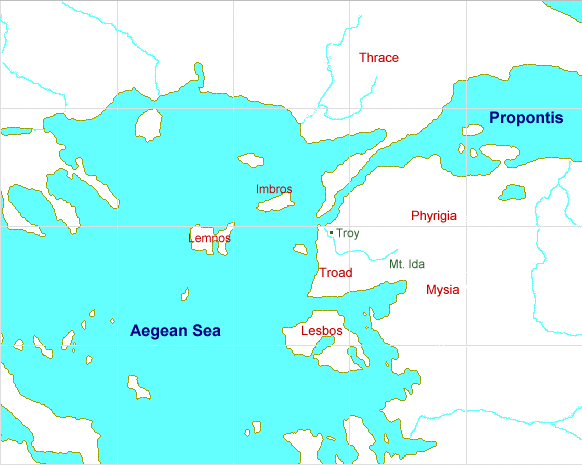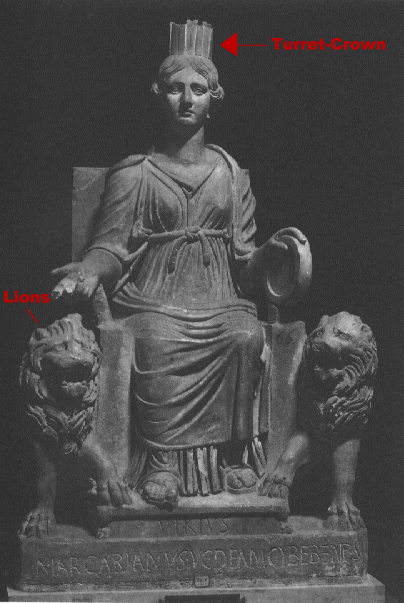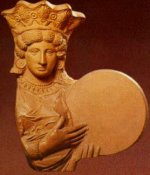
Trans Mythology: Cybele
Crown'ed Cybele's great turret
Rocks and crumbles on her head;
Roar the lions of her chariot
Toward the wilderness, unfed,
Scornful children are not mute
"Mother, mother, walk afoot
Since Pan is dead."- Elizabeth Barrett Browning, "The Dead Pan"
Phrygia
Cybele was the great mother figure of Phyrgia, in Asia Minor. Phrygia is well-known for:
- the city of Troy (Ilium) where the Trojan horse story story takes place
- the city of Gordium, where the legendary Gordian knot was tied
- the home of King Midas, who turned everything he touched to gold

Recognizing Cybele
The two most common features in images of Cybele are the turret-like crown that she wears (in one version of the myth, while chasing Attis in a jealous rage, she lifts up the walls of Pessinus and puts them on her head), and her two lions (sometimes she's pulled in a chariot by two lions).

Mater Deum Magna Idaea

A statue of Cybele, from the Metro'on web site
There are a number of versions of the myth of Cybele.
- Cybele begins life as Agdisthus, a hermaphroditic
God/dess. Because Agdisthus scared
the other
gods, Dionysos snuck up on the sleeping
Agdisthus
and tied the Agdisthus' penis to
a tree.
When Agdisthus woke up, the phallus
engorged,
and sudden movement severed it. Rather
than
crippling Agdisthus, this act changes
her/him
into Cybele, the great mother of
the gods.
A pomegranate tree grew up from Agdisthus' blood, and when a river nymph named Nana ate a pomegranate from the tree, she became pregnant and gave birth to Attis, who then becomes Cybele's lover. [Pollack 1997:187]
- There was once a hermaphrodite named Agdistis.
Because he was more than simply man or woman,
the gods castrated* him, burying the severed male genitals near
a river bank. These grew into an
almond tree
from which the river god's daughter
plucked
a nut. Placing it upon her breast,
she became
pregnant with a child, later named
Attis.
Attis grew up to become a handsome man, and Agdistis, now a woman, fell in love with him. Attis, however, was engaged to marry a king's daughter. Agdistus, in a jealous rage, caused both Attis and the King to castrate themselves. [Monaghan 1994:216-217]
- Agdistis was born when Zeus masterbated on
Cybele's sacred rock (Zeus had tried,
unsuccessfully,
to seduce Cybele). His spilled semen
impregnated
the earth with the hermaphrodite.
Then Dionysus
castrated Agdistis by tying his male
genitals
to a tree while Agdistis slept; the
genitals
were torn off when Agdistis moved
to wake.
From Agdistis's blood, a pomogranate tree sprang up. Nana, a king's daughter, ate its fruit and gave birth to Attis. Although both Cybele and Agdistis lusted after him, Attis was ordered to marry the Phrygian king Midas' daughter. In a jealous rage, Agdistis drove the wedding party crazy. The princess cut off her breasts and Attis cut off his genitals. From the blood, violets sprang up, and an almond tree. [Monaghan 1994: 217]
- A similar account tells us that Cybele was
sleeping, disguised as the rock Agdos.
Zeus
was a far younger diety who attempted
to
rape her, but was unable to penetrate
her,
so he ejaculated on the ground. Since
the
ground was part of Cybele, she conceived
a hermaphroditic child, Agdistis.
Agdistis
was unpleasant and violent, so Dionysus
drugged
him with alcohol and, "to make
his life
easier" tied his male members
to a tree.
Agdistis, in this version of the myth, dies from the wound, but the blood causes an almond or pomegranite tree to bloom, and Attis is born when Nana picks the fruit and places it next to her skin.
When Attis grew to adulthood, Cybele took him as a lover, bearing him through the world in her lion-drawn chariot. But Attis turned his attention toward another woman. Because Cybele was the earth itself, there was nowhere that Attis could make love to this other woman without Cybele knowing about it; when he tried, Cybele naturally surprised him, and in punishment, she drove him mad. Attis emasculated himself in an act of contrition, and bled to death beneath a pine tree. [Monaghan 1981: 84-85]
- Ovid tells us that Cybele took Attis as a lover, demanding perpetual fidelity. When Cybele discovered Attis making love with a river nymph, Attis was ashamed and castrated himself with a stone and was transformed into a tree. [Monaghan 1994: 217]
- Attis was a young and handsome shepherd from Celaenae with whom Cybele fel in love. She chose him as her priest and imposed upon him a vow of chastity. When Attis broke his vow by sleeping with the daughter of the river Sangarius, Cybele drove him insane. While in this frenzied delirium, Attis emasculated himself. When he recovered, he was on the verge of killing himself when Cybele changed him into a fir-tree. [Larousse 1968:150]
* This account, from Patricia Monaghan, uses the term "castrated", although castration more accurately refers to removal of the testicles, rather than removal of the all the male genitals.
Copyright © 2001 by B.C. Holmes. Last updated September 9th, 2001.
Back to my religion page.